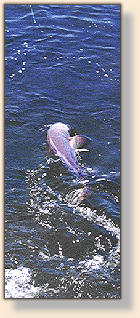 Catch & Release has been practiced since the late 30's. Lee Wulff said in 1938,
"a game fish is much too valuable to be caught once." He was an engaging, aggressive,
abrasive and tireless advocate of catch and release. And, he was right. He was the
first to encourage sporting advocates to start thinking about protection of the species
and slot limits. Bag and slot limits are pretty common today and some species have
returned in big numbers. In our saltwater estuaries in Florida we have seen Spotted
Sea Trout, Redfish, Black Drum, Snook and other inshore species rebound after the
ban on gillnets. Over a 10-year period declining populations of game fish from netting
has shown a promising rebound. Yet, that is not to say that numbers can't decline
from other factors, such as over fishing.
Catch & Release has been practiced since the late 30's. Lee Wulff said in 1938,
"a game fish is much too valuable to be caught once." He was an engaging, aggressive,
abrasive and tireless advocate of catch and release. And, he was right. He was the
first to encourage sporting advocates to start thinking about protection of the species
and slot limits. Bag and slot limits are pretty common today and some species have
returned in big numbers. In our saltwater estuaries in Florida we have seen Spotted
Sea Trout, Redfish, Black Drum, Snook and other inshore species rebound after the
ban on gillnets. Over a 10-year period declining populations of game fish from netting
has shown a promising rebound. Yet, that is not to say that numbers can't decline
from other factors, such as over fishing.
More than 100,000 game fish species are taken annually from Mosquito Lagoon.
Much of this is a result of fish charters with multiple anglers taking fish for the table.
You don't have to be a rocket scientist to figure this out.
Area guides have increased more than 50% over the past decade. In Mosquito Lagoon
alone the guide population has grown to the point that a lot of pressure is being put on
game fish species. This is evident from fish that school and won't take flies, baitfish, or
lures. They are skittish and leery of anything that is not normal in their environment.
Schools of large fish can be seen laying down on the bottom in as little as three feet
of water. They look petrified.
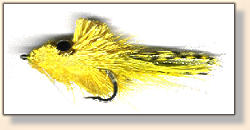 With more than 20 to 50 charters fishing at any given time on a daily basis, naturally
the fishing will become more challenging. This puts a lot of pressure on the fish populations.
Consider a boat with 2 anglers taking their limit of sea trout (5 each) for 200 trips annually
times more than 100 fishing parties. You could see how these numbers could have a
devastating impact on the species over a period of time. For fish reaching adulthood,
the slot limits of 15- to 20- and one over 20 - increases the kill ratio. It makes you
wonder if the bag limits are two high. Perhaps Sea Trout, like redfish should be limited
to one per day per angler. Add to this the fact that the U.S. Fish and Wildlife folks do
not enforce slot limits. I know they don't because I've seen fish at the ramp in coolers
where all 5 fish are over 30-inches. This has been going on for years. The taking of
too many adult fish causes a serious imbalance. What happened to the Grayling in
Michigan can happen anywhere on our planet.
With more than 20 to 50 charters fishing at any given time on a daily basis, naturally
the fishing will become more challenging. This puts a lot of pressure on the fish populations.
Consider a boat with 2 anglers taking their limit of sea trout (5 each) for 200 trips annually
times more than 100 fishing parties. You could see how these numbers could have a
devastating impact on the species over a period of time. For fish reaching adulthood,
the slot limits of 15- to 20- and one over 20 - increases the kill ratio. It makes you
wonder if the bag limits are two high. Perhaps Sea Trout, like redfish should be limited
to one per day per angler. Add to this the fact that the U.S. Fish and Wildlife folks do
not enforce slot limits. I know they don't because I've seen fish at the ramp in coolers
where all 5 fish are over 30-inches. This has been going on for years. The taking of
too many adult fish causes a serious imbalance. What happened to the Grayling in
Michigan can happen anywhere on our planet.
This is the reason for catch and release. It is more commonly accepted as the ethic of
fly-fishing. And the bass tournaments require it as well. Slowly it will be acceptable for
light tackle fisherman. Catch and release ensures the survival of properly released fish.
Proper handling of fish is really important.
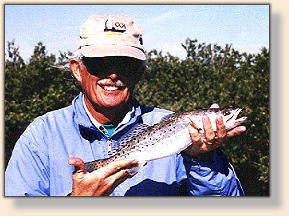
Here an angler cradles the fish for a quick picture and then is placed into the water, not
thrown back. Released fish are available for other anglers to enjoy. I'm not saying that
you can't keep your catch. But you don't have to keep the bag limit. If you are going
to eat your catch immediately, isn't two enough?
If you don't intend on keeping your fish use a barbless hook or pinch down the barbs
with pliers.
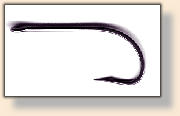 This allows a quicker release and less stress on the fish. Especially with fly-fishing
there really isn't any need to have a barbed hook. Barbs are only on hooks to keep
the bait there. If you aren't using bait then you don't need a barb.
This allows a quicker release and less stress on the fish. Especially with fly-fishing
there really isn't any need to have a barbed hook. Barbs are only on hooks to keep
the bait there. If you aren't using bait then you don't need a barb.
Play your fish quickly. Long fights will stress a fish and reduces it's chance for survival.
Avoid using nets and excessive handling. It is true that when you first hookup you'll
want the fish to take the line, sometimes into the backing, but reel in your quarry as
soon as you can and leave it in the water, remove the hook and prepare your fish
for release.
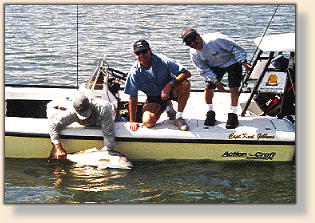
Release your fish without removing them from the water. Be gentle and cradle the fish,
moving them back and forth until they can swim away on their own. Kent Gibbens
shows the proper handling for release of a 23-pound redfish. Another angler or
charter captain can capture the photo without stressing out the fish. [Publisher's
Note: removing the fish from the water, even for photos is not legal everywhere!
Know the regulations where you fish.]
Inshore game fish, especially in Florida, have a lot of teeth, sharp gill plates and rough
mouths. Don't stick your hand into a fish's mouth, and don't kiss your fish either.
Be careful removing a hook. It is best to use a fish hook remover, pliers or a
slide-remover (pictured).

Never remove a deeply swallowed hook from the fish's throat or stomach. If the hook
is not easily removed, cut the leader and leave the hook in the fish. It will eventually
work free or be digested by the fish's stomach acid.
Release the fish once it has revived from the ordeal. So you've fooled one fish. You
can do it again and you'll eventually experience the excitement of releasing predator
fish back into their environment. Please practice Catch and Release, you'll be
glad you did. ~ Doug
About Doug:
Capt. Doug Sinclair has relocated from New Smyrna Beach, Florida to
Grantsboro, NC. He specializes in fly-fishing and light tackle charters.
Doug charters the Coastal Carolina area of New Bern or Oriental.
Catch him on the web at
www.flyfishacademy.net or call him at (252) 745-3500.
Doug is also a Sponsor here on FAOL.
|





 With more than 20 to 50 charters fishing at any given time on a daily basis, naturally
the fishing will become more challenging. This puts a lot of pressure on the fish populations.
Consider a boat with 2 anglers taking their limit of sea trout (5 each) for 200 trips annually
times more than 100 fishing parties. You could see how these numbers could have a
devastating impact on the species over a period of time. For fish reaching adulthood,
the slot limits of 15- to 20- and one over 20 - increases the kill ratio. It makes you
wonder if the bag limits are two high. Perhaps Sea Trout, like redfish should be limited
to one per day per angler. Add to this the fact that the U.S. Fish and Wildlife folks do
not enforce slot limits. I know they don't because I've seen fish at the ramp in coolers
where all 5 fish are over 30-inches. This has been going on for years. The taking of
too many adult fish causes a serious imbalance. What happened to the Grayling in
Michigan can happen anywhere on our planet.
With more than 20 to 50 charters fishing at any given time on a daily basis, naturally
the fishing will become more challenging. This puts a lot of pressure on the fish populations.
Consider a boat with 2 anglers taking their limit of sea trout (5 each) for 200 trips annually
times more than 100 fishing parties. You could see how these numbers could have a
devastating impact on the species over a period of time. For fish reaching adulthood,
the slot limits of 15- to 20- and one over 20 - increases the kill ratio. It makes you
wonder if the bag limits are two high. Perhaps Sea Trout, like redfish should be limited
to one per day per angler. Add to this the fact that the U.S. Fish and Wildlife folks do
not enforce slot limits. I know they don't because I've seen fish at the ramp in coolers
where all 5 fish are over 30-inches. This has been going on for years. The taking of
too many adult fish causes a serious imbalance. What happened to the Grayling in
Michigan can happen anywhere on our planet.
 This allows a quicker release and less stress on the fish. Especially with fly-fishing
there really isn't any need to have a barbed hook. Barbs are only on hooks to keep
the bait there. If you aren't using bait then you don't need a barb.
This allows a quicker release and less stress on the fish. Especially with fly-fishing
there really isn't any need to have a barbed hook. Barbs are only on hooks to keep
the bait there. If you aren't using bait then you don't need a barb.